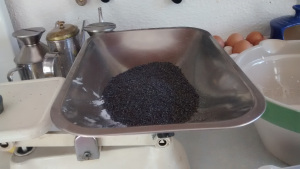I saw a baking tin recently whilst shopping – by the American company Nordic ware – as it was at a greatly discounted price, I could not resist buying it.
I have similar tins bought from both Lidl and from Marks & Spencer and used these in previous recipes.
This one is much thicker and heavier.
Babka refers to the shape of the cake and babeczki are smaller – they are buns.
I tried our various recipes using this new tin and found it was rather difficult to get the babeczki – the buns – out of the tin and many just ended up being fed to the birds.
Cake Seeking Bird
One of a pair of large wood pigeons that come into my garden – looking for cake!

At last I found two recipes that work well with this tin!
Tip
I have found that you have to grease the tins very well – I use melted butter and then I dust with dried Breadcrumbs (or you can use flour).

Carrot Spice Babeczki
- These are based on a recipe for carrot cake which I use and has dark brown sugar as one of its ingredients – this is very popular in Britain where sugars made from sugar cane are readily available.
- In Poland where sugar is made from sugar beet, white sugar is the norm in the shops.
Ingredients
- 225g self raising flour
- 1 teaspoon mixed spice ( I like the mixture from Marks & Spencer)
- Grated rind of 1 orange
- 150g of soft dark brown sugar
- 150g of medium grated peeled carrots.
- 2 eggs
- 150ml of sunflower oil
- 2 tablespoons of milk
Method
- Grease and dried breadcrumb (or flour) the tin ... you might have some mixture left over – so use bun cases in bun tins for the remainder.
- Pre-heat the oven to GM5 – 190°C.

- Place the flour and the mixed spice into a large bowl.
- Add the sugar (sometimes I have found that this sugar has a few lumps in it – I mix these into the flour with my finger tips to remove them.)
- Stir in the carrots and the orange rind.

- Make a well in the centre of the mixture and add the beaten egg, oil and milk.
- Mix well together with a wooden spoon until the mixture is evenly blended.
- Fill the tins around 2/3rds full.
- Bake for around 15 to 18 minutes.

- Let them cool slightly, then, using a spatula ease the buns gently out of the tins.
- Dust well with icing sugar.
Chocolate Babeczki
- Here I have used the same recipe as for my Chocolate Babka with a slightly different recipe for the chocolate icing.
- Evaporated milk is used for the cake and the icing – a very small tin – 170g is enough for both.

Ingredients – cake
- 200g self raising flour
- 2250g caster sugar
- 1/2 teaspoon salt
- 25g cocoa powder
- 200g butter or block margarine
- 2 eggs
- 75ml evaporated milk
- 75ml water
- 2 drops of vanilla essence
Method – cake
- Grease and dried breadcrumb (or flour) the tin ... you might have some mixture left over – so use bun cases in bun tins for the remainder.
- Pre-heat the oven oven to GM 4 – 180°C.
- You need to use a large bowl for this cake mixture.
- Rub the butter into the flour so that the mixture is like breadcrumbs.
- Stir in the salt, sugar and cocoa powder.
- Lightly beat the eggs and add the evaporated milk, the water and the drops of vanilla essence.
- Stir the liquid mixture into the dry ingredients mixing thoroughly to give a thick batter.
- Fill the tins around 2/3rds full.
- Bake for around 15 to 20 minutes.
- Let them cool slightly then using a spatula ease the buns gently out of the tins.
- You can then dust with icing sugar or add an icing.
Ingredients – icing
- 40g butter
- 2 level tablespoons of cocoa
- 2 tablespoons of evaporated milk
- Around 180g icing sugar
Method – icing
- Gently melt the butter in a small saucepan and add the cocoa, stirring continuously.
- Remove from the heat and beat in the evaporated milk.
- Beat in the icing sugar until the mixture is thick.
- Pour the icing over the babeczki.





























































